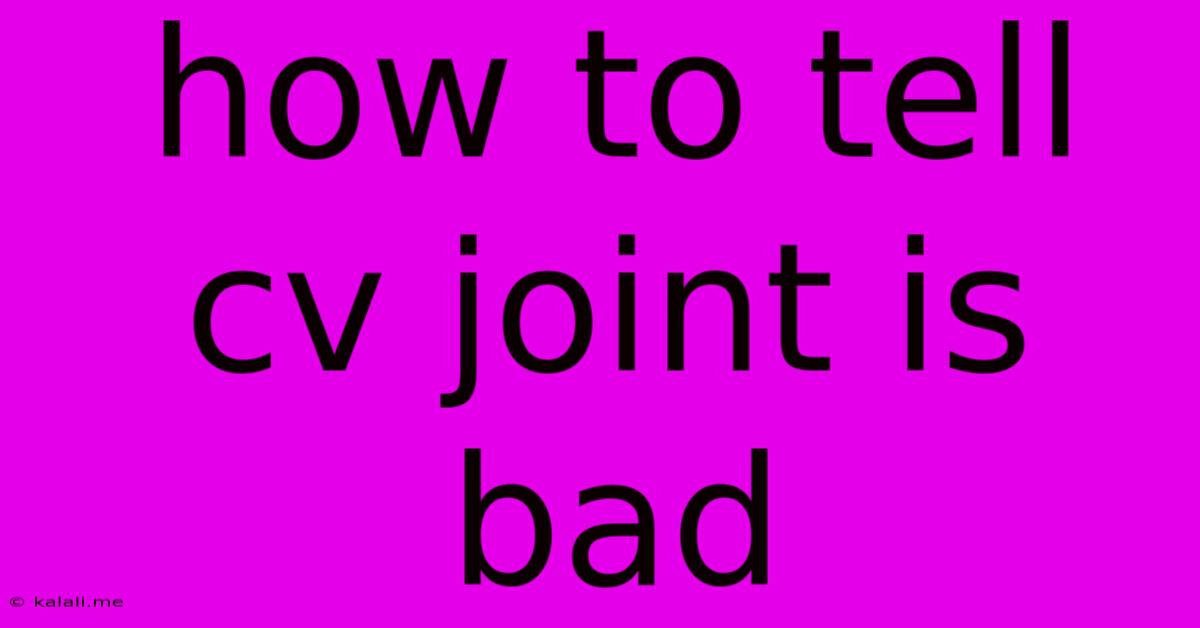How To Tell Cv Joint Is Bad
Kalali
Jun 05, 2025 · 3 min read

Table of Contents
How to Tell if Your CV Joint is Bad: A Comprehensive Guide
Meta Description: Experiencing vibrations, clicking noises, or difficulty turning? This comprehensive guide helps you identify the symptoms of a bad CV joint and know when it's time for a replacement. Learn how to diagnose the problem and avoid costly repairs down the road.
A failing Constant Velocity (CV) joint can lead to dangerous driving conditions, so it's crucial to know the signs of trouble. Ignoring a bad CV joint can result in complete joint failure, leaving you stranded and potentially causing an accident. This guide will walk you through the common symptoms, helping you determine if your CV joint needs attention.
Understanding Your CV Joints
Before diving into the symptoms, let's quickly understand what CV joints do. These crucial components allow power to be transmitted from your car's transmission to the wheels, even when the wheels are turning at different speeds (like when cornering). They're designed to handle significant stress, but over time or due to damage, they can fail.
Key Symptoms of a Bad CV Joint
Several tell-tale signs indicate a failing CV joint. Pay close attention to these:
1. Clicking or Popping Noises: This is often the first and most noticeable symptom. You'll likely hear clicking or popping sounds, particularly when turning corners, accelerating, or decelerating. The noise often originates from the area of the wheel. The severity of the noise might increase as the joint deteriorates.
2. Vibration in the Steering Wheel or Car: A failing CV joint can cause vibrations felt throughout the steering wheel, the floor, or even the entire car, especially at higher speeds or when turning. This vibration is caused by uneven power transfer due to the damaged joint.
3. Difficulty Steering: Steering might become difficult or feel heavy, especially when turning. This is a direct consequence of the uneven power transfer and increased friction within the damaged joint.
4. Grease Leaks: CV joints are sealed with grease to lubricate their moving parts. A visible grease leak indicates a damaged boot, which is the protective covering around the joint. This leak allows grease to escape and contaminates the joint, leading to premature wear and tear. This leak is a strong indicator of potential issues even if you haven’t noticed other symptoms.
5. Grinding or Growling Noise: In later stages of failure, you might hear a grinding or growling noise coming from the wheel area, particularly when under load. This indicates significant wear and damage within the joint itself.
When to Seek Professional Help
If you notice any of these symptoms, it's crucial to have your vehicle inspected by a qualified mechanic. Ignoring these issues can lead to complete joint failure, resulting in a loss of control and potentially dangerous driving situations. Early detection and replacement can prevent costly repairs and ensure your safety.
Preventing CV Joint Issues
While you can't always prevent wear and tear completely, there are steps you can take to prolong the lifespan of your CV joints:
- Regular vehicle maintenance: Following the manufacturer's recommended maintenance schedule is essential.
- Careful driving: Avoid harsh acceleration and cornering, which puts extra strain on the joints.
- Inspecting boots regularly: Check the CV joint boots for any signs of damage or leaks.
By understanding the signs of a bad CV joint and seeking timely professional help, you can ensure the safety and longevity of your vehicle. Remember, ignoring these issues can be costly and potentially dangerous.
Latest Posts
Latest Posts
-
I Love That For You Meaning
Jun 07, 2025
-
Can You Stack Plus 4 In Uno
Jun 07, 2025
-
What Is A Theme For Darkness And Light
Jun 07, 2025
-
How To Find Dirt On Someone
Jun 07, 2025
-
How To Clean Vinyl Siding Without Scrubbing
Jun 07, 2025
Related Post
Thank you for visiting our website which covers about How To Tell Cv Joint Is Bad . We hope the information provided has been useful to you. Feel free to contact us if you have any questions or need further assistance. See you next time and don't miss to bookmark.